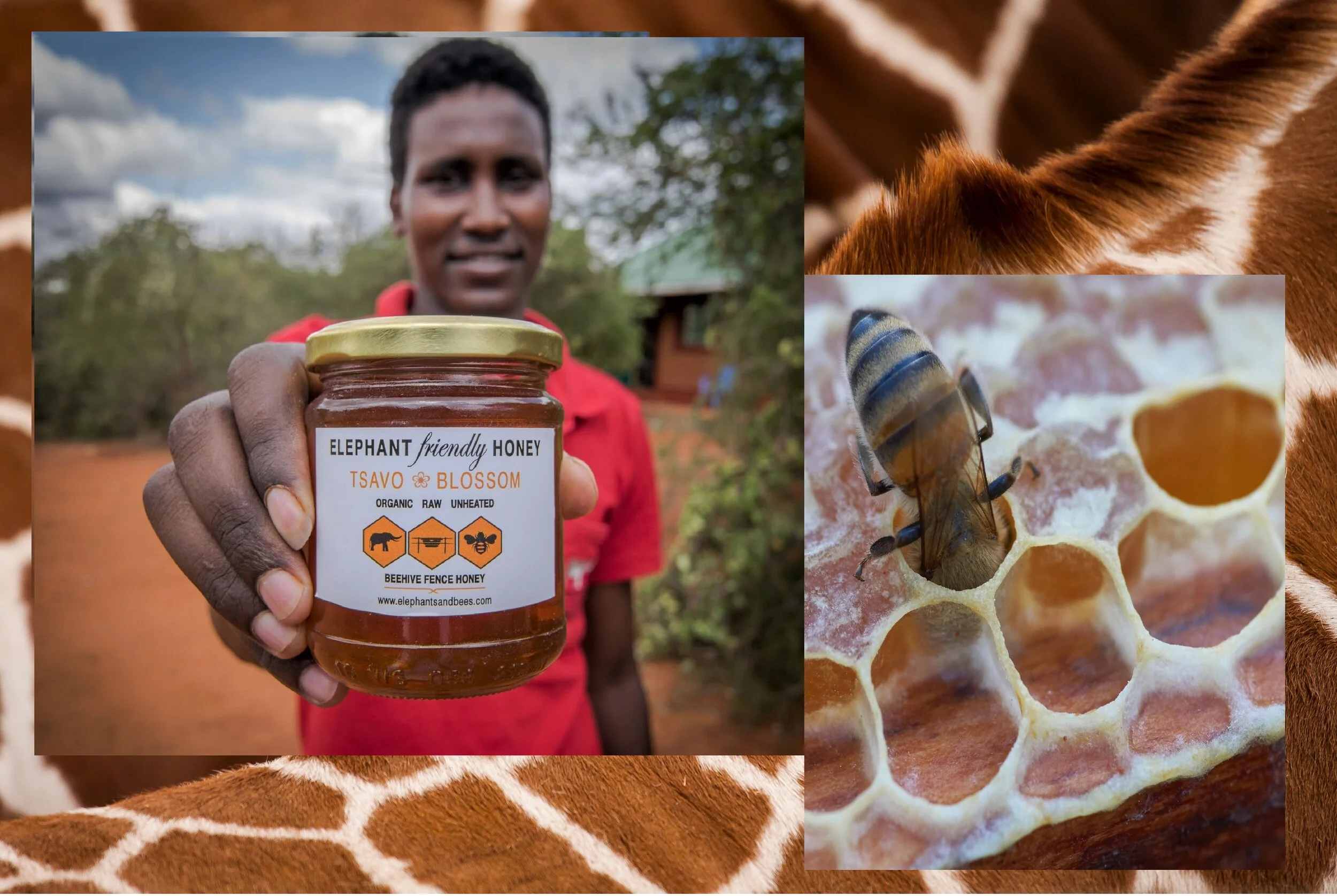Beehive Fences Can Help Mitigate Human-Elephant Conflict
/By Hannah Thomasy. First published on Mongabay.com
Human-elephant conflict poses major threats to the well-being of both humans and animals. Crop-raiding by elephants across Asia and Africa can be devastating for small farmers, leading to food insecurity, lost opportunity costs, and even death. Crop-raiding and property damage can also result in negative attitudes towards elephant conservation and retaliatory killings of elephants.
Finding effective and inexpensive solutions has proven extremely difficult. Farmers guarding their fields at night lose sleep and put themselves in potentially close proximity to hungry elephants. Killing “problem” elephants is not only inhumane, but is also ineffective at reducing human-elephant conflict. Electric fences, while effective in theory, often fail in practice because they are costly and difficult to maintain.
Bees to the rescue
More recently, conservationists have explored the use of beehive fences as a humane and eco-friendly way to protect crops from elephants. Zoologist Lucy King of the NGO Save the Elephants told Mongabay the idea came from Kenyan farmers, who noticed that elephants avoided foraging in trees that contained beehives.
In the late 2000s, King and several Save the Elephants colleagues conducted a pilot study to determine if beehive fences could protect farms in Kenya. They placed locally constructed beehives on fence posts every 8 meters (about 26 feet) and connected them with wires. If an elephant tried to enter between the hives, it would knock into the wires, causing the hives to sway and disturbing the bees. In this study, the researchers found that elephant raids were reduced by almost half on a farm with a beehive fence compared to an unprotected farm.
Since then, King and her colleagues have conducted two sets of field trials in Kenya. The first set of trials, published in 2011, found that beehive fences were better at protecting crops than traditional thorn bush barriers. The second set of trials, published in 2017, reported that 80 percent of elephants that approached the beehive fences were deterred from entering the farms. However, this second study did not report data from control farms – those not protected with beehive fences – so we cannot know if this represents a significant improvement.
Currently, King and her colleagues at Save the Elephants are studying or implementing beehive fences for crop protection in 15 countries in Africa and four countries in Asia. The beehive fence concept has generated high levels of interest and acceptance among farmers in Africa and Asia. In Kenya, participating farms more than doubled over the course of field trials as farmers requested to join, and in Thailand, over 80 percent of cassava and sugar cane plantation owners reported that they were interested in trying beehive fences.
However, comparatively few studies on beehive fences have been performed in Asia. One small study in India observed that elephants were less likely to enter agricultural areas through areas with beehive fences, although statistical evaluations were not performed.
Beehive fences can provide many benefits to a community. In addition to humanely deterring elephants from entering farms, bees provide pollination services (which could increase crop yields) and honey (which farmers can sell to diversify their income). King and colleagues also found that even long-term use of beehive fences does not seem to negatively impact wild bee diversity.
Problems and solutions
Although these trials seem to show great success overall, beehive fences have yet to be implemented at a broad scale. Wildlife veterinarian Richard Hoare, a member of the IUCN Human-Wildlife Conflict Task Force states that, “the sample sizes of farms in bee fence projects claiming success are too small to be extrapolated to general use.”
Much of the action in keeping elephants away from farmers’ properties happens at night.
Furthermore, beehive fences don’t work everywhere, and several factors can decrease their efficacy, including the design of the fences, the species of bee, and bee activity. A trial in Zimbabwe did not find any difference in crop damage between farms with beehives and those without. However, this may be because hives were hung on poles and not connected with wire. In other words, elephants could easily pass between the hives without disturbing the bees.
Efficacy may also be affected by the species of bees that live in different regions. King says that the honey bees kept in many parts of Asia – called Apis cerana indica – are much less aggressive than African bee species and are less effective at deterring elephants.
Even for beehives inhabited by the same species, not all hives deter elephants equally. A trial in Gabon found that while high-activity hives were very effective at protecting fruit trees from elephants, low-activity hives (and empty hives) were less effective. Unfortunately, this same study found that bees in very high-activity hives may produce less honey and be more aggressive than bees in low-activity hives.
Challenges inherent to beekeeping have affected the effectiveness of some beehive fence projects. Conservationist and biological anthropologist Katarzyna Nowak told Mongabay that in many places in Africa, beekeepers simply provide hives and must wait for bees to come colonize them, sometimes resulting in low hive occupancy and consequently, less effective beehive fences. Furthermore, it can be hazardous to work with hundreds of stinging insects. African bees can be very aggressive – during one trial, two goats were stung to death, and people could not work in nearby fields when a hive was knocked down.
Due to hazards like these, Hoare notes that the beehive fence technique, “will most likely only work in rural communities with a previous culture of beekeeping.” Indeed, Nowak says that it’s very important to take community history and preferences into account on these projects. “It’s as much about how people receive the particular deterrent method – and therefore maintain it – as it is about the efficacy of it,” she says.
Another problem is that hives and the honey within them are subject to theft – sometimes by other humans, but often by honey badgers. Colonies often abandon a hive after a honey badger attack. However, simple additions like cages or motion-activated lights have shown promise in reducing honey badger impact on beehives.
King says one of the biggest threats to beehive fence projects in more arid areas is actually climate change. “With climate change, the rainfall has become so erratic that we’re getting erratic flowering seasons, so the bees are being affected,” she says. “We’re losing colonies because they’re not holding on through the dry seasons…I don’t know what it means for our project long-term.”
Some of the challenges of keeping bees — like hive maintenance, attacks by honey badgers, bee stings, and problems with hive occupation during the dry season — could be solved by using a stimulus that mimics bees rather than actual bees.
Some trials have shown that buzzing bee sounds seemed to disturb elephants – one study found that 94 percent of African elephant families quickly left the area when the sound of disturbed bees was played. In India, news reports have detailed minor reductions in elephant fatalities in train collisions by using bee noises near the train tracks (although it’s unclear if this small decrease merely represents random variation that occurs year-to-year). Another study found that chemicals contained in bee alarm pheromones seemed to cause elephants to hesitate or retreat.
But these bee-mimickers aren’t universally applicable either. A study in South Africa noted that elephants appeared, at most, mildly disturbed or attentive in response to bee noises alone. Another study found that Asian elephants did not retreat from beehive noises significantly more than they moved away from control noises (although they did move farther away when movement occurred).
The human-elephant conflict toolbox
The moral of the story is that no single technique is 100 percent effective. Researchers acknowledge that several strategies should be used to foster the peaceful coexistence of elephants and people. “I’m a huge fan of what we call the human-elephant conflict toolbox,” says King. “There’s a variety of options you can use to keep elephants out of your farm and to live better with elephants. Without question, beehive fences should be one of those tools, but it’s not necessarily a silver bullet for the entire problem, nor are any of the others.”
Several other strategies have been determined to be at least partially effective, including setting off small handheld fireworks putting chili oil on fences surrounding crops. King says her team is experimenting with growing crops that are regionally appropriate but less palatable for elephants. These include tea, ginger, sunflowers, and chilis.
Overall, King says that beehive fences have been quite successful and word of that success has spread. “We have people queuing up for beehive fences, literally coming to the research center and emailing me from all over the world, requesting these.”
Related: Elephants Are Very Scared of Bees. That Could Save Their Lives New York Times Jan. 26, 2018
Elephants + Bees































